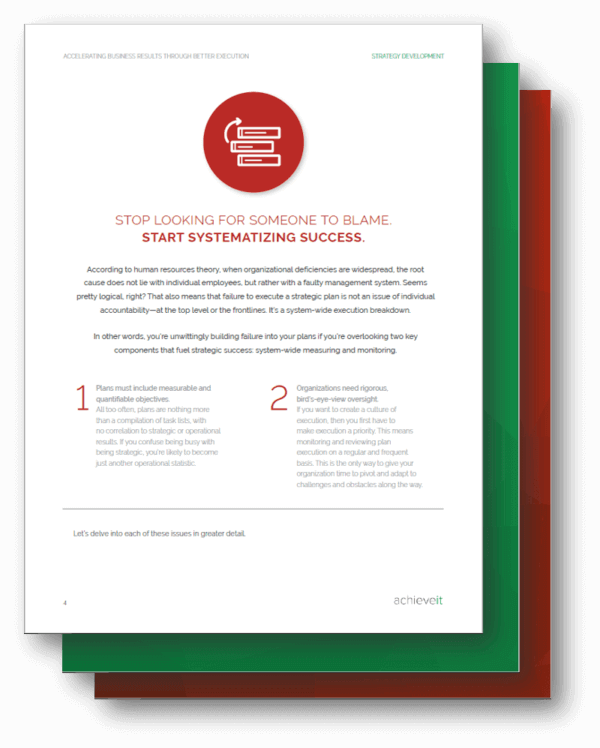When we define strategic management for our customers, we define it as the collection of goals, objectives, strategies, and tactics that organizations use to coordinate and align resources and actions with the mission, values, and vision of the company.
But you don’t have to trust our definition – Business Dictionary defines strategic management as:
The systematic analysis of the factors associated with customers and competitors (the external environment) and the organization itself (the internal environment) to provide the basis for maintaining optimum management practices. The objective of strategic management is to achieve better alignment of corporate policies and strategic priorities.
So it’s pretty safe to say that we know what strategic management is – in theory. However, the problem comes when we try to figure out how to take that information and turn it into actionable strategies that actually lead to the results we want.
Strategic Planning vs. Strategic Management
Understanding the basics of strategic management and planning is a critical first step to the success of most organizations. But that’s not enough; you also need to know how to create a strategy and, most importantly, how to execute that strategy.
This leads us to the difference between strategic planning and strategic management. Strategic planning is the process of determining what we want and where we want to go. It is – as the name suggests – a plan that we create for success. In other words, it is the roadmap you create to guide you toward success.
Chances are, if you are reading this right now, you are familiar with this planning process. You have a strategic plan or are in the process of creating one. You’ve got this part.
However, where businesses seem to run into problems is when moving on from the planning stage into the execution, or strategic management, stage.
If your strategic plan is the roadmap, then the strategic management plan is the vehicle you take to navigate that map. Without the map, you will probably get lost along the way. However, without the vehicle, you will never go anywhere. It’s essentially your execution plan.
You cannot have one without the other, yet businesses try to skip the strategic management plan all the time. That’s why 70-90% of plans businesses create will fail – because of a lack of execution.
So the obvious conclusion is that if you want to use strategic planning and management principles successfully, just execute all of your plans! Simple, right? Of course, it’s not – otherwise businesses around the world wouldn’t struggle so much. So how can you use a strategic management plan to improve execution across your organization?
FREE RESOURCE
Accelerate Business Results Through Better Strategy Execution
Download this guide to understand the key components of effective plan review and monitoring, while creating measurable and quantifiable objectives.

What Can You Do to Increase the Success Rate of Your Strategic Management Plan
I once read a great article from consulting firm, Gilmore & Associates Inc., in which they analyzed 12 reasons they saw such a high failure rate in strategic plans. Here are five takeaways that can help you improve your strategic management plan’s chances of success:
Break It Down

When you created your strategic plan, you probably had reasons for writing it as you did. You knew what you wanted to accomplish. You hopefully knew what levels of success you wanted to see.
For example, if your plan was to increase sales by 25% over the next two years, then you knew what you wanted (more sales), when you wanted it (over the course of the next two years), and how you defined success (seeing an increase of at least 25%.)
That’s the easy part. However, problems typically begin during the setting of metrics and milestones intended to lead to the result.
If a year and a half from now you haven’t gotten to a 10% increase in sales, then it is likely you will not get the rest of the way in the next half year. That’s pretty easy to see.
That’s why execution of strategic management plans typically not only focuses on that ultimate goal, but on the small goals that will get you to the big marker. When you create a plan, consider setting out smaller, measurable points throughout the process.
Then, analyze those results on a consistent schedule. This will make sure that you keep yourself on the path to success and, if you do fall off that path, allow you to quickly recover before it’s too late.
Foggy Focuses

Another reason it is hard to execute strategic plans is because we make them too vague. Strategic plan: to become the best in the biz.
Okay. But…how? What’s the standard for “best in the biz?”
Big dreams are great. Have them. But when it comes to creating a plan for success, make your goals more actionable.
How will you determine if you have achieved your goal of becoming the best? Does that mean your SEO rankings are higher than all of your competitors? Your sales numbers are double those of the competition? When surveyed about your industry, that your potential customers always think of your name first?
When you’re creating your plan, make sure that you narrow down your focus to the specifics. Every goal should state at least the following:
- The problem you are trying to address
- The solution or result you want
- The timeframe in which you want to accomplish this goal
- The manner in which you will achieve that result
Looking at the sales example from above, our goal framework would look like this:
- Problem: Sales numbers are not as high as we want them
- Solution or Result: A 25% increase in overall sale
- Time Frame: Two years
- Manner: hiring more/better salespeople; increasing training; improving product; expanding contact and networking lists; attending more conferences; etc. (And this becomes much easier to execute if we break this down even further. E.g., increase training by holding required monthly thought leadership seminars for all sales support. Expand the sales team by four sales support staff by the end of the second quarter, etc.)
The clearer the focus – on both the goals and the metrics used to measure the success of those goals – the easier it is to execute. The easier it is to measure success and execute, the more successful your strategic management plan will ultimately be.
Improve Collaboration
It is easy to tunnel down into your day-to-day activities and forget about the rest of the team. Business silos are epidemic. In fact, they’re so prevalent, that ‘silo mentality’ actually became a phrase with its own definition.
Yet, how can marketing survive without the valuable insights they can glean from sales? And how can sales sell if they don’t fully understand the products the engineers are developing?
Every department affects and relies on every other department. That is why a lack of collaboration leads to multiple, unaligned strategic plans, which are harder to execute and less likely to succeed.
In order to avoid this, you should do two main things:
- Collaborate across departments in the planning stage in order to create a strategic plan that will benefit the entire company.
- Collaborate across departments in the strategic management stage in order to make sure that the strategic plan is being executed and is moving towards results that will make the entire company better.
Embed Accountability
The next reason so many plans fail is because there is no accountability. Once you have a plan, who will be responsible for accomplishing it?
Make sure you assign specific actions and tasks to individuals. Check-in to ensure everyone knows what they are supposed to be doing, how they are supposed to do it, and why it’s important. Then, have a system in place to hold people accountable for their results.
Plan vs. Process
The final step for improving your strategic management plan revolves around knowing the difference between a plan and a process.
As Gilmore & Associates, Inc., put it, “A strategic plan is not an end goal; it’s the beginning of a process or a cycle.”
There are four steps to successfully fulfilling your strategic management plan, and therefore, your entire strategic plan:
- Periodically review your plan.
- Figure out what you are doing right and what you could be doing better.
- Expand on and improve the plan.
- Keep moving – if you reach your goals, it is time to make newer, bigger ones.
Strategic Management: Don’t Plan to Plan, Plan to Execute
A plan is nothing if it is not executed. So once you have that roadmap, make sure you get in the driver’s seat and follow the map to success you just created for yourself, putting your strategic management plan to work.
The AchieveIt Execution Management Platform can help. It gives you a bird’s eye view of your plan and its status in real time. Not only does it keep people accountable by letting you assign every task to the individual in charge and then requiring updates at the frequency you desire, but it quickly compiles the metrics you are tracking and uses dashboard technology to show you exactly where you are on the path towards achieving your strategic management initiatives.
To find out more, request a demo.
FREE RESOURCE
The ROI of Efficient Execution
Download this guide and the companion calculator worksheet to show your team what you’re leaving on the table without enabling plan visibility, organizational alignment, or automated accountability.

About AchieveIt
AchieveIt is the platform that large organizations use to get their biggest, most important initiatives out of the boardroom and into reality. Too many great ideas never quite make it across the finish line, because there’s no real way to keep everyone on course and keep everything on track. What does it take to actually guide these initiatives all the way through to completion? You’ve got to:
- Get everything in view – so you can see what’s happening with every initiative, at every level, from the enterprise to the individual, in real-time.
- Get everyone engaged – with an easy-to-use platform that connects your organization from the executive leadership to the project teams, keeping everyone accountable and on the same page.
- Get every possible advantage – not only because you have the premier platform in this space, but because you can draw on the experience and best practices of our execution experts.
That’s why everyone from global corporations, to regional healthcare systems, to federal agencies have turned to AchieveIt for their Integrated Plan Management. Let’s actually do this.
Ready to improve your plan execution?
Organizations of all types leverage AchieveIt to manage, execute, and connect their most important initiatives. Replace manual processes & siloed systems with interconnected plans in a single, automated platform.



